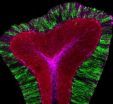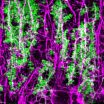(Press-News.org) A new study from The Johns Hopkins University shows that the brain cells surrounding a mouse's neurons do much more than fill space. According to the researchers, the cells, called astrocytes because of their star-shaped appearance, can monitor and respond to nearby neural activity, but only after being activated by the fight-or-flight chemical norepinephrine. Because astrocytes can alter the activity of neurons, the findings suggest that astrocytes may help control the brain's ability to focus.
The study involved observing the cells in the brains of living, active mice over long periods of time. A combination of genetically engineered mice and advanced microscopy allowed the researchers to visualize the activity of astrocyte networks in different regions of the brain to learn how these abundant supporting cells are controlled.
The scientists monitored astrocytes in the area of the brain responsible for controlling movement and saw that the cells often increased their activity as the mice walked on treadmills — but not always, and sometimes astrocytes became active when the animals were not moving. This lack of consistency suggested to the researchers that the astrocytes were not responding to nearby neurons, as had been thought.
Similarly, astrocytes in the vision processing area of the brain did not necessarily become active when the mice were stimulated with light, but they were sometimes active, even in the dark. The team solved both mysteries when they tested the idea that the astrocytes needed a signal to "wake them up" before they could respond to nearby neurons. That is how they found that norepinephrine, the brain's broadly distributed fight-or-flight signal, primes the astrocytes in both locations to "listen in" on nearby neuronal activity.
"Astrocytes are among the most abundant cells in the brain, but we know very little about how they are controlled and how they contribute to brain function," says Dwight Bergles, Ph.D., professor of neuroscience, who led the study. "Since memory formation and other important functions of the brain require a state of attention, we're interested in learning more about how astrocytes help create that state."
For example, Bergles says, "We know that astrocytes can regulate local blood flow, provide energy to neurons and release signaling molecules that alter neuronal activity. They could be doing any or all of those things in response to being activated. It is also possible that they act as a sort of megaphone to broadcast local norepinephrine signals to every neuron in the brain." Whatever the case may be, researchers now know that astrocytes are not idle loiterers. This ability to study astrocyte network activity in animals as they do different things will help to reveal how these cells contribute to brain function.
INFORMATION:
This research will be published in the journal Neuron on June 18.
This work was supported by grants from the National Institute on Alcohol Abuse and Alcoholism (AA022239), the National Institute of Mental Health (MH084020), the National Multiple Sclerosis Society, and the Brain Science Institute and the Science of Learning Institute, both at the Johns Hopkins University School of Medicine.
On the Web:
Link to article in Neuron: http://dx.doi.org/10.1016/j.neuron.2014.04.038
Bergles Lab: http://neuroscience.jhu.edu/resources/directory/faculty/dwight-bergles
http://www.bergleslab.com
Related stories:
Researchers Discover Dynamic Behavior of Progenitor Cells in Bran
http://www.hopkinsmedicine.org/news/media/releases/researchers_discover_dynamic_behavior_of_progenitor_cells_in_brain
Mysterious Cells May Play Role in ALS
http://m.hopkinsmedicine.org/news/media/releases/mysterious_cells_may_play_role_in_als
Brain's White Matter: More 'Talkative' Than Once Thought
http://m.hopkinsmedicine.org/news/media/releases/brains_white_matter_more_talkative_than_once_thought
Fight-or-flight chemical prepares cells to shift brain from subdued to alert
Star-shaped brain cells 'eavesdrop' on neurons, but only when primed
2014-06-18
ELSE PRESS RELEASES FROM THIS DATE:
Modeling how neurons work together
2014-06-18
A newly-developed, highly accurate representation of the way in which neurons behave when performing movements such as reaching could not only enhance understanding of the complex dynamics at work in the brain, but aid in the development of robotic limbs which are capable of more complex and natural movements.
Researchers from the University of Cambridge, working in collaboration with the University of Oxford and the Ecole Polytechnique Fédérale de Lausanne (EPFL), have developed a new model of a neural network, offering a novel theory of how neurons work together when ...
Stem pipeline problems to aid STEM diversity
2014-06-18
PROVIDENCE, R.I. [Brown University] — Decades of effort to increase the number of minority students entering the metaphorical science, technology, engineering, and math (STEM) pipeline, haven't changed this fact: Traditionally underrepresented groups remain underrepresented. In a new paper in the journal BioScience, two Brown University biologists analyze the pipeline's flawed flow and propose four research-based ideas to ensure that more students emerge from the far end with Ph.D.s and STEM careers.
Senior author Andrew G. Campbell, associate professor of biology, said ...
Nanoparticles from dietary supplement drinks likely to reach environment, say scientists
2014-06-18
Nanoparticles are becoming ubiquitous in food packaging, personal care products and are even being added to food directly. But the health and environmental effects of these tiny additives have remained largely unknown. A new study now suggests that nanomaterials in food and drinks could interfere with digestive cells and lead to the release of the potentially harmful substances to the environment. The report on dietary supplement drinks containing nanoparticles was published in the journal ACS Sustainable Chemistry & Engineering.
Robert Reed and colleagues note that food ...
BU-lead study shows surprising spread of spring leaf-out times
2014-06-18
(Boston) – Despite conventional wisdom among gardeners, foresters and botanists that woody plants all "leaf out" at about the same time each spring, a new study organized by a Boston University biologist found a surprisingly wide span of as much as three months in leaf-out times. Significantly, observations the past two springs of 1,597 woody plants in eight botanical gardens in the U.S., Canada, Germany and China suggest that species differences in leaf-out times could impact the length of the growing season and the activities of birds, insect and other animals and therefore ...
Innovative technologies in rural areas improve agriculture, health care
2014-06-18
TAMPA, Fla. (June 18, 2014) – The current special issue of Technology and Innovation is devoted to articles on both innovations in rural regions and general articles on technology and innovation, including an article from the National Academy of Inventors (NAI) by McDevitt et al. that discusses the value of technology transfer for universities beyond money.
The five papers in this special issue of Technology and Innovation dealing with innovations in rural regions include an editorial, an analysis of the value of networks for European organic farmers and conventional ...
Self-repairing mechanism can help to preserve brain function in neurodegenerative diseases
2014-06-18
New research, led by scientists at the University of Southampton, has found that neurogenesis, the self-repairing mechanism of the adult brain, can help to preserve brain function in neurodegenerative diseases such as Alzheimer's, Prion or Parkinson's.
The progressive degeneration and death of the brain, occurring in many neurodegenerative diseases, is often seen as an unstoppable and irrevocable process. However, the brain has some self-repairing potential that accounts for the renewal of certain neuronal populations living in the dentate gyrus, a simple cortical region ...
When it comes to numbers, culture counts
2014-06-18
CAMBRIDGE, MA -- American children learn the meanings of number words gradually: First they understand "one," then they add "two, "three," and "four," in sequence. At that point, however, a dramatic shift in understanding takes place, and children grasp the meanings of not only "five" and "six," but all of the number words they know.
Scientists have also seen this pattern in children raised speaking other languages, including Japanese and Russian. In all of these industrialized nations, number learning begins around age 2, and children fully understand numbers and counting ...
3D breast imaging could revolutionize cancer screening
2014-06-18
Leesburg, VA, June 17, 2014—In community-based radiology practice, mammography screening with 3D digital breast tomosynthesis (DBT) yielded lower recall rates, an increased overall cancer detection rate, and an increased detection rate for invasive cancer compared with 2D digital mammography (DM).
In the largest report to date, researchers at Washington Radiology Associates, PC, with offices in Washington, DC; Virginia; and Maryland, conducted a study of more than 59,000 patients. The results were striking: an increase in the detection rate for cancer overall of 28.6% ...
Exposure to TV violence related to irregular attention and brain structure
2014-06-18
INDIANAPOLIS -- Young adult men who watched more violence on television showed indications of less mature brain development and poorer executive functioning, according to the results of an Indiana University School of Medicine study published online in the journal Brain and Cognition.
The researchers used psychological testing and MRI scans to measure mental abilities and volume of brain regions in 65 healthy males with normal IQ between the age of 18 and 29, specifically chosen because they were not frequent video game players.
Lead author Tom A. Hummer, Ph.D., assistant ...
Wildlife scientists map fishing resources to assist land managers, anglers
2014-06-18
Anglers in North Carolina and Virginia who are looking for privacy at good fishing spots should head for the mountains, according to a Virginia Tech study of the capacity, quality, and demand of freshwater recreational fishing sites in the two states.
"Our objective was to map a cultural ecosystem service by identifying the key features that influence anglers' enjoyment, such as environmental quality, accessibility, and fish abundance," said Amy Villamagna, a research scientist with the College of Natural Resources and Environment's fish and wildlife conservation department. ...
LAST 30 PRESS RELEASES:
Exposure to natural light improves metabolic health
As we age, immune cells protect the spinal cord
New expert guidance urges caution before surgery for patients with treatment-resistant constipation
Solar hydrogen can now be produced efficiently without the scarce metal platinum
Sleeping in on weekends may help boost teens’ mental health
Study: Teens use cellphones for an hour a day at school
After more than two years of war, Palestinian children are hungry, denied education and “like the living dead”
The untold story of life with Prader-Willi syndrome - according to the siblings who live it
How the parasite that ‘gave up sex’ found more hosts – and why its victory won’t last
When is it time to jump? The boiling frog problem of AI use in physics education
Twitter data reveals partisan divide in understanding why pollen season's getting worse
AI is quick but risky for updating old software
Revolutionizing biosecurity: new multi-omics framework to transform invasive species management
From ancient herb to modern medicine: new review unveils the multi-targeted healing potential of Borago officinalis
Building a global scientific community: Biological Diversity Journal announces dual recruitment of Editorial Board and Youth Editorial Board members
Microbes that break down antibiotics help protect ecosystems under drug pollution
Smart biochar that remembers pollutants offers a new way to clean water and recycle biomass
Rice genes matter more than domestication in shaping plant microbiomes
Ticking time bomb: Some farmers report as many as 70 tick encounters over a 6-month period
Turning garden and crop waste into plastics
Scientists discover ‘platypus galaxies’ in the early universe
Seeing thyroid cancer in a new light: when AI meets label-free imaging in the operating room
Neutrophil-to-lymphocyte ratio may aid risk stratification in depressive disorder
2026 Seismological Society of America Annual Meeting
AI-powered ECG analysis offers promising path for early detection of chronic obstructive pulmonary disease, says Mount Sinai researchers
GIMM uncovers flaws in lab-grown heart cells and paves the way for improved treatments
Cracking the evolutionary code of sleep
Medications could help the aging brain cope with surgery, memory impairment
Back pain linked to worse sleep years later in men over 65, according to study
CDC urges ‘shared decision-making’ on some childhood vaccines; many unclear about what that means
[Press-News.org] Fight-or-flight chemical prepares cells to shift brain from subdued to alertStar-shaped brain cells 'eavesdrop' on neurons, but only when primed





